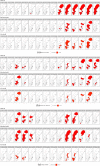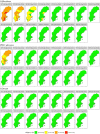A joint Bayesian spatiotemporal risk prediction model of COVID-19 incidence, IC admission, and death with application to Sweden
- PMID: 36465998
- PMCID: PMC9707215
- DOI: 10.1007/s00168-022-01191-1
A joint Bayesian spatiotemporal risk prediction model of COVID-19 incidence, IC admission, and death with application to Sweden
Abstract
The three closely related COVID-19 outcomes of incidence, intensive care (IC) admission and death, are commonly modelled separately leading to biased estimation of the parameters and relatively poor forecasts. This paper presents a joint spatiotemporal model of the three outcomes based on weekly data that is used for risk prediction and identification of hotspots. The paper applies a pure spatiotemporal model consisting of structured and unstructured spatial and temporal effects and their interaction capturing the effects of the unobserved covariates. The pure spatiotemporal model limits the data requirements to the three outcomes and the population at risk per spatiotemporal unit. The empirical study for the 21 Swedish regions for the period 1 January 2020-4 May 2021 confirms that the joint model predictions outperform the separate model predictions. The fifteen-week-ahead spatiotemporal forecasts (5 May-11 August 2021) show a significant decline in the relative risk of COVID-19 incidence, IC admission, death and number of hotspots.
Supplementary information: The online version contains supplementary material available at 10.1007/s00168-022-01191-1.
© The Author(s) 2022.
Conflict of interest statement
Conflict of interestNot applicable.
Figures





Similar articles
-
Spatiotemporal high-resolution prediction and mapping: methodology and application to dengue disease.J Geogr Syst. 2022;24(4):527-581. doi: 10.1007/s10109-021-00368-0. Epub 2022 Feb 19. J Geogr Syst. 2022. PMID: 35221792 Free PMC article.
-
A Spatiotemporal Analytical Outlook of the Exposure to Air Pollution and COVID-19 Mortality in the USA.J Agric Biol Environ Stat. 2022;27(3):419-439. doi: 10.1007/s13253-022-00487-1. Epub 2022 Jan 28. J Agric Biol Environ Stat. 2022. PMID: 35106052 Free PMC article.
-
Bayesian spatiotemporal forecasting and mapping of COVID-19 risk with application to West Java Province, Indonesia.J Reg Sci. 2021 Sep;61(4):849-881. doi: 10.1111/jors.12533. Epub 2021 May 7. J Reg Sci. 2021. PMID: 34230688 Free PMC article.
-
Small Area Forecasting of Opioid-Related Mortality: Bayesian Spatiotemporal Dynamic Modeling Approach.JMIR Public Health Surveill. 2023 Feb 10;9:e41450. doi: 10.2196/41450. JMIR Public Health Surveill. 2023. PMID: 36763450 Free PMC article.
-
Identifying spatiotemporal patterns of COVID-19 transmissions and the drivers of the patterns in Toronto: a Bayesian hierarchical spatiotemporal modelling.Sci Rep. 2022 Jun 7;12(1):9369. doi: 10.1038/s41598-022-13403-x. Sci Rep. 2022. PMID: 35672355 Free PMC article.
Cited by
-
Deep learning in public health: Comparative predictive models for COVID-19 case forecasting.PLoS One. 2024 Mar 14;19(3):e0294289. doi: 10.1371/journal.pone.0294289. eCollection 2024. PLoS One. 2024. Retraction in: PLoS One. 2025 Apr 9;20(4):e0321232. doi: 10.1371/journal.pone.0321232. PMID: 38483948 Free PMC article. Retracted.
References
-
- Adin A, Goicoa T, Hodges J, Schnell P, Ugarte M. Alleviating confounding in spatio-temporal areal models with an application on crimes against women in India. Stat Model. 2022 doi: 10.1177/1471082X211015452. - DOI
-
- Agarwal D, Gelfand A, Citron-Pousty S. Zero-inflated models with application to spatial count data. Environ Ecol Stat. 2002;9(4):341–355. doi: 10.1023/A:1020910605990. - DOI
-
- Aleman V, Fernan E, Varon D, Surani S, Gathe J, Varon J. Socioeconomic disparities as a determinant risk factor in the incidence of COVID-19. Chest. 2020;158(4):A1039. doi: 10.1016/j.chest.2020.08.966. - DOI
-
- Arani HZ, Manshadi GD, Atashi HA, Nejad AR, Ghorani SM, Abolghasemi S, Bahrani M, Khaledian H, Savodji PB, Hoseinian M, Bejandi AK, Abolghasemi S. Understanding the clinical and demographic characteristics of second coronavirus spike in 192 patients in Tehran Iran: a retrospective study. PLoS One. 2021;16(3):e0246314. doi: 10.1371/journal.pone.0246314. - DOI - PMC - PubMed
LinkOut - more resources
Full Text Sources
